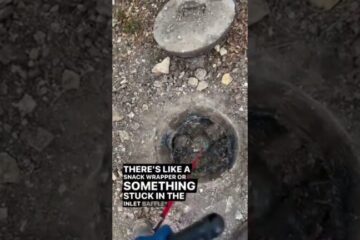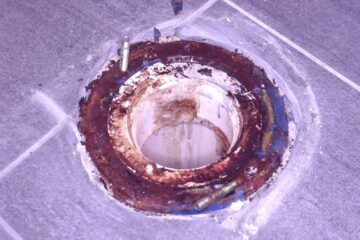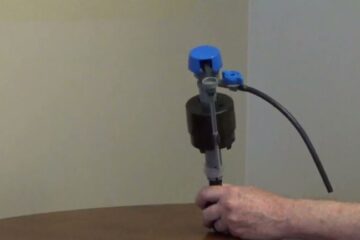How Do P-Traps Work?
Discover the importance of P-Traps in plumbing systems and how they prevent sewer fumes from entering your home. Learn about their history, functionality, common issues, maintenance, and innovative designs. Ensure your plumbing system remains odor-free and functioning properly.
Have you ever wondered about those peculiar shapes in the plumbing pipes under your sink or toilet? Well, those are called P-Traps, and they play a crucial role in your plumbing system. Shaped like the letter P, these traps are designed to prevent sewer fumes from entering your home by trapping water.
P-Traps have been around for almost 250 years, with the first versions invented in Britain in the late 18th century. They allow water to flow through while blocking fumes, ensuring that your home doesn’t smell like a toilet.
However, P-Traps can face issues like evaporation and clogs, which can compromise their effectiveness. Proper slope and ventilation are also important for maintaining P-Traps. Excitingly, new inventions and variations of P-Traps are being developed, offering innovative solutions for homeowners.
So, in this article, we will delve into the importance of P-Traps in plumbing systems, explaining how they work and highlighting five drain issues to watch out for. You’ll gain valuable insights into maintaining a well-functioning plumbing system and ensure that your home remains fresh and free from sewer odors.
Introduction
When you look under your sink or at the back of your toilet, you may notice some funny-shaped pipes. These are known as P-Traps, an essential component of plumbing systems. P-Traps have been around for almost 250 years and play a crucial role in preventing sewer fumes from entering your home. In this comprehensive article, we will explore the definition, purpose, design, functionality, and common issues of P-Traps.
We will also discuss the importance of proper maintenance and troubleshooting, as well as innovations in P-Trap design. Additionally, we will touch upon professional installation and plumbing codes, costs, and considerations, and conclude with a summary of key takeaways.
What are P-Traps?
Definition and Purpose
A P-Trap, named for its unique shape resembling the letter “P,” is a plumbing device used to trap water and prevent sewer fumes from entering the living space. It is typically installed under sinks, bathtubs, and toilets, but can also be found in other plumbing fixtures. The primary purpose of a P-Trap is to provide a barrier between the drainage system and your home, ensuring that foul odors and harmful gases are contained within the sewer system.
Basic Design
The design of a P-Trap is relatively simple. It consists of a horizontal pipe connected to a vertical pipe, forming the shape of a “P.” The horizontal pipe connects directly to the drainage system, while the vertical pipe extends upward to serve as a vent. This design allows water to flow through the trap while trapping a small amount of water in the curve to create a seal against sewer fumes.
History of P-Traps
P-Traps have a long history, with the first versions being invented in Britain in the late 18th century. Alexander Cumming is credited with inventing the S curve, an early predecessor to the modern P-Trap, in 1775. Over a century later, Thomas Crapper, also from Britain, modified the design to resemble the U shape we are familiar with today. Despite its humble origins, the P-Trap has remained largely unchanged for over a century and continues to be an essential part of plumbing systems worldwide.

Importance of P-Traps
Prevention of Sewer Fumes
One of the primary reasons P-Traps are crucial in plumbing systems is their ability to prevent sewer fumes from entering your home. The water trapped in the P-Trap creates a barrier that blocks the movement of foul odors and harmful gases from the sewer system. Without a properly functioning P-Trap, your home would be filled with unpleasant smells and potentially harmful gases, posing a significant health risk to you and your family.
Health and Safety
In addition to preventing sewer fumes, P-Traps also play a vital role in protecting your health and safety. The seal created by the water in the P-Trap prevents insects, rodents, and other pests from entering your home through the plumbing system. It also helps prevent the spread of bacteria, viruses, and other harmful microorganisms that may be present in the sewer system.
Avoiding Unpleasant Odors
Not only do P-Traps prevent foul odors from entering your home, but they also help to eliminate unpleasant smells caused by decomposing materials in the drains. The water in the P-Trap acts as a barrier, preventing these odors from permeating the living space and creating an unpleasant environment.
Protecting the Plumbing System
P-Traps also serve to protect the plumbing system itself. The trapped water in the curve of the P-Trap helps to lubricate and maintain the integrity of the pipe joints, preventing dryness and potential damage. Additionally, the water in the P-Trap helps to flush away debris and prevent blockages that can lead to plumbing issues.
Functionality of P-Traps
Allowing Water Flow
While P-Traps primarily function as odor barriers, they also allow water to flow freely through the drainage system. The design of the P-Trap ensures that only a small amount of water is trapped in the curved section, allowing the rest of the water to flow through unimpeded. This allows for effective drainage and prevents water from backing up into the fixture.
Blocking Sewer Fumes
The primary function of a P-Trap is to create a seal that blocks the movement of sewer fumes into your home. The water trapped in the P-Trap creates a physical barrier that prevents these foul odors from permeating the living space. The vent pipe in the P-Trap also helps to facilitate the release of any trapped air or fumes, further enhancing its effectiveness as an odor barrier.
Preventing Backflow
In addition to blocking sewer fumes, P-Traps also serve as a defense against backflow. Backflow occurs when water or waste flows in the opposite direction, potentially contaminating the clean water supply. The water trapped in the P-Trap helps to create a barrier that prevents backflow from occurring, protecting the integrity of both the plumbing system and the water supply.
Common Issues with P-Traps
Evaporation
One common issue with P-traps is the evaporation of the water within the trap. If a drain is not used frequently, or if the water in the trap is not periodically replenished, the water level may drop below the necessary threshold, allowing sewer fumes to enter the home. To prevent this, it is important to regularly run water through drains that are not regularly used, such as in guest bathrooms or basement drains. Additionally, the installation of air admittance valves (AAVs) can help maintain the water level and prevent evaporation in less frequently used drains.
Clogs and Blockages
P-Traps can also become clogged or blocked by debris, such as hair, grease, or foreign objects. These blockages can impede the flow of water and lead to slow drainage or even complete blockage. Regular cleaning and maintenance of P-Traps are essential to prevent clogs and ensure proper functioning. The use of drain screens or traps can also help to catch debris before it enters the P-Trap and causes blockages.
Leaks and Cracks
Over time, P-Traps may develop leaks or cracks due to wear and tear, corrosion, or improper installation. These leaks can lead to water damage, mold growth, and further deterioration of the plumbing system. Regular inspection of P-Traps for signs of leaks, such as water stains or dampness, is crucial in identifying and addressing any issues before they escalate.
Maintenance and Troubleshooting
Regular Cleaning
Regular cleaning of P-Traps is essential to prevent clogs, eliminate foul odors, and ensure proper functioning. To clean a P-Trap, start by placing a bucket or container beneath the trap to catch any water or debris. Unscrew the slip nuts on either side of the trap and carefully remove the trap. Clean out any debris or residue using a brush or a plumber’s snake. Once cleaned, reassemble the trap, ensuring that the slip nuts are securely tightened.
Checking for Proper Slope
Ensuring the proper slope of drain pipes is essential for the effective functioning of P-Traps. According to international plumbing codes, a quarter-inch slope for every foot of pipe is recommended. It is crucial to check the slope of drain pipes and ensure they are sloping downward to facilitate proper drainage and prevent standing water or blockages. Improper slope can lead to slow drainage and potential clogs.
Ensuring Proper Ventilation
Proper ventilation is essential for P-Traps to function effectively and prevent the buildup of sewer gases. Blocked or obstructed vent pipes can cause the P-Trap to lose its sealing ability, allowing foul odors to enter the living space. Regularly inspecting and maintaining vent pipes, such as on the roof, is crucial to ensure proper ventilation and prevent issues with P-Traps.
Addressing Clogs and Blockages
In the event of a clogged or blocked P-Trap, there are several methods for addressing the issue. One common method is to use a plunger or a plumber’s snake to dislodge the blockage and restore proper flow. Alternatively, chemical drain cleaners can be used, although these should be used sparingly and with caution as they can be harmful to pipes and the environment. If these methods are ineffective, it may be necessary to call a professional plumber to address the issue.
Repairing or Replacing Damaged P-Traps
In cases where P-Traps are cracked, leaking, or otherwise damaged, it is important to repair or replace them promptly to prevent further issues. Small cracks can often be repaired using epoxy or plumber’s tape, while larger cracks or significant damage may require the replacement of the entire trap. It is recommended to consult a professional plumber for any repairs or replacements to ensure proper installation and prevent further damage to the plumbing system.
Innovations in P-Traps
Alternative Shapes and Designs
While the traditional P-Trap design has remained largely unchanged for over a century, there are new variations and alternative shapes being developed. These alternative designs aim to improve functionality, ease of cleaning, and overall aesthetics. Examples include bottle traps, telescopic traps, and decorative traps that blend seamlessly with modern bathroom or kitchen fixtures.
Advanced Materials
Advancements in materials technology have also led to the development of P-Traps made from more durable and corrosion-resistant materials. Stainless steel and PVC (polyvinyl chloride) traps offer improved longevity and performance compared to traditional brass or plastic traps. These advanced materials help to mitigate issues such as corrosion and degradation over time.
Eco-Friendly Options
In recent years, there has been a push for more eco-friendly plumbing solutions, including P-Traps. Some manufacturers are now producing P-Traps made from recycled materials or utilizing sustainable manufacturing practices. Additionally, water-saving designs are being developed to further reduce water consumption and promote sustainability in plumbing systems.
Professional Installation and Plumbing Codes
Importance of Professional Installation
While some plumbing tasks can be tackled as DIY projects, the installation of P-Traps is best left to professional plumbers. Proper installation ensures that the P-Trap functions effectively and prevents leaks or other issues. Professional plumbers have the expertise, tools, and knowledge of local plumbing codes to install P-Traps correctly and in compliance with regulations.
Plumbing Codes and Regulations
P-Traps, like all plumbing fixtures, are subject to specific codes and regulations to ensure safety, functionality, and compliance with municipal standards. These codes dictate the proper installation, venting requirements, and maintenance guidelines for P-Traps. It is essential to consult local plumbing codes and engage a professional plumber to ensure that P-Traps meet all necessary requirements.
Costs and Considerations
Installation Costs
The cost of installing a P-Trap can vary depending on factors such as the location, complexity of the installation, and whether any modifications or repairs are needed. Generally, the installation cost for a standard P-Trap is relatively affordable, especially when compared to potential repairs or safety hazards resulting from improper installation.
Maintenance Expenses
The maintenance expenses associated with P-Traps are relatively minimal. Regular cleaning and maintenance can be performed with basic household tools and materials. However, if significant repairs or replacements are required, the cost may vary depending on the extent of the damage and the materials used.
Benefits Outweighing Costs
Despite the potential costs associated with installation, maintenance, and repairs, the benefits of properly functioning P-Traps outweigh the expenses. The prevention of sewer fumes, protection of health and safety, and avoidance of unpleasant odors are invaluable aspects of a well-maintained plumbing system. Additionally, investing in quality materials and professional installation can help ensure the longevity and effectiveness of P-Traps, further maximizing their benefits.
P-Traps, with their distinctive shape and important role in plumbing systems, are essential for maintaining a safe and odor-free home. These simple yet effective devices prevent sewer fumes, pests, and harmful gases from entering your living space. It is crucial to understand the role and functionality of P-Traps, as well as the importance of regular maintenance and professional installation. By taking proper care of your P-Traps, you can ensure a smoothly functioning plumbing system and enjoy a comfortable, healthy living environment.



